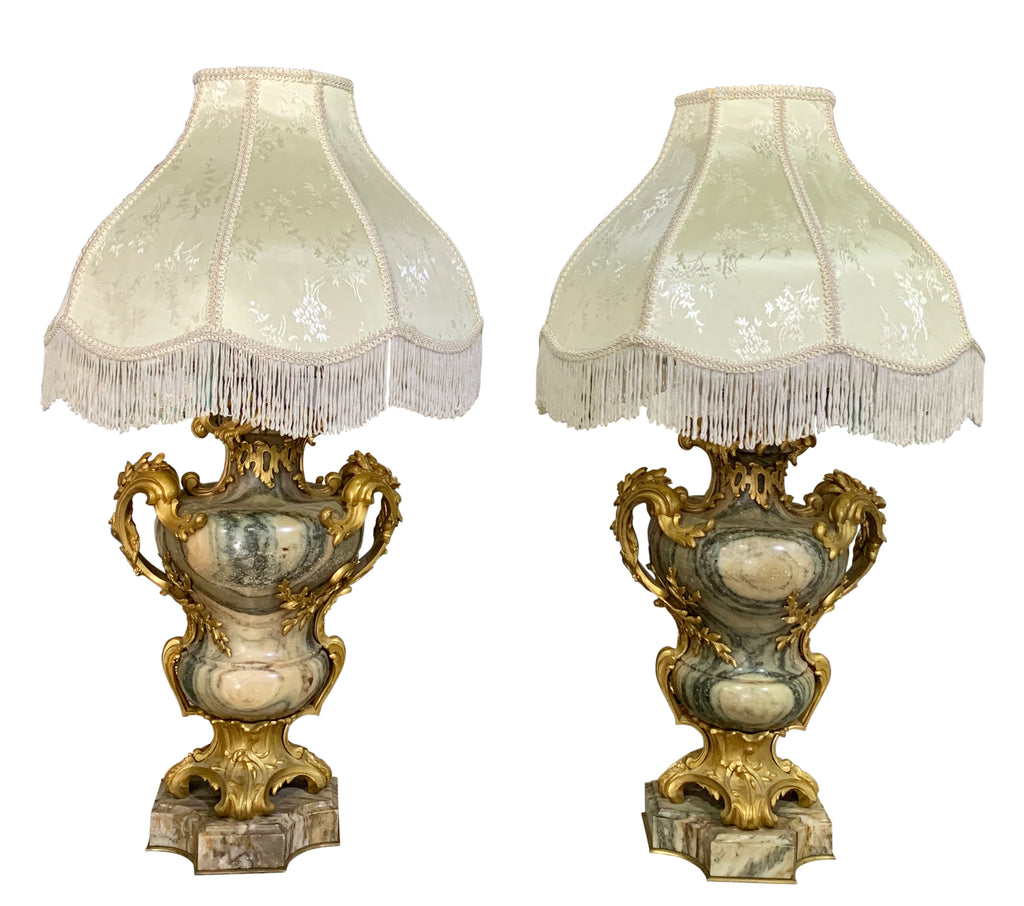A PAIR OF FRENCH ORMOLU MOUNTED CIPOLLINO MARBLE LAMPS BY MAISON MILLET
$23,000.00
Behold a delightful pair of 19th-century French Louis XV style gilt-bronze mounted Cipollino marble urns, skillfully crafted by the esteemed Maison Millet and transformed into exquisite lamps. Each Cipolin Antique de Grèce marble vase features twin foliate-cast handles, resting upon a scrolled base atop a shaped marble plinth, epitomizing elegance and craftsmanship synonymous with the Louis XV era.
The reverse of the gilt bronze mounting proudly bears the stamp 'MB' representing the hallmark of Maison Millet, a renowned artisan of the time. Dating back to circa 1890, these pieces stand as timeless examples of opulence and refined design from an era celebrated for its artistic grandeur.
France, Circa 1890
Dimension as lamps with shades:Height: 31" (78.74 cm)
Diameter: 18" (45.72 cm)
Dimensions of urns:
Height: 17.5" (44.45 cm)
width: 12" (30.48")
Depth: 8" (20.32 cm)
Maison Millet was a French furniture making house which operated in the last half of the 19th Century, and especially flourished during the period known as the Belle Epoque in France. It made furniture both in emerging modern styles like Art Nouveau, as well as in the more classic 18th Century Louis XV and Louis XVI styles, and in many cases blended a number of different styles to create their own unique pieces. The firm was founded by Theodore Millet in 1853. They specialized not only in antique furniture but also in bronze sculptures, vases and other decorative pieces from their workshop in Paris. The firm was so highly regarded that in 1902 the Palace of Versailles commissioned them to replicate Marie Antoinette's famous Armoire à Bijoux. They also made a number of designs for the master maker of the period, Francois Linke.
Cipollino marble ("onion-stone") was a variety of marble used by the ancient Greeks and Romans, whose Latin term for it was marmor carystium (meaning "marble from Karystos"). It was quarried in several locations on the south-west coast of the Greek island of Euboea, between the modern-day cities of Styra and Karystos. Some of these ancient quarries survive with a mine-face of over 100 metres.
Diameter: 18" (45.72 cm)
Dimensions of urns:
Height: 17.5" (44.45 cm)
width: 12" (30.48")
Depth: 8" (20.32 cm)
Maison Millet was a French furniture making house which operated in the last half of the 19th Century, and especially flourished during the period known as the Belle Epoque in France. It made furniture both in emerging modern styles like Art Nouveau, as well as in the more classic 18th Century Louis XV and Louis XVI styles, and in many cases blended a number of different styles to create their own unique pieces. The firm was founded by Theodore Millet in 1853. They specialized not only in antique furniture but also in bronze sculptures, vases and other decorative pieces from their workshop in Paris. The firm was so highly regarded that in 1902 the Palace of Versailles commissioned them to replicate Marie Antoinette's famous Armoire à Bijoux. They also made a number of designs for the master maker of the period, Francois Linke.
Cipollino marble ("onion-stone") was a variety of marble used by the ancient Greeks and Romans, whose Latin term for it was marmor carystium (meaning "marble from Karystos"). It was quarried in several locations on the south-west coast of the Greek island of Euboea, between the modern-day cities of Styra and Karystos. Some of these ancient quarries survive with a mine-face of over 100 metres.












